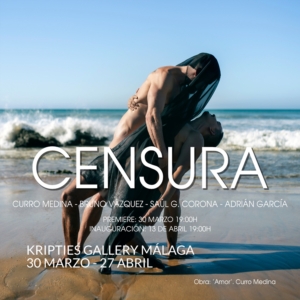Desde el próximo día 30 de marzo podremos disfrutar y compartir las distintas visiones de los artistas Curro Medina, Bruno Vázquez Alonso, Saúl G. Corona y Adrián García sobre la censura en el arte actual y cómo moldea su obra.
El discurso de «La censura mata el arte» es sumamente relevante y actual en el contexto en el que vivimos. La censura ha llegado a ser una amenaza real y peligrosa para la libertad de expresión y la creatividad artística.
Desde los ataques terroristas en París hasta la actualidad, hemos sido testigos de una creciente agresividad en los intentos de censura. La falta de libertad en el ámbito artístico, así como en otros aspectos de la vida humana, ha convertido nuestro mundo en un lugar en el que la hipersensibilidad y lo políticamente correcto dominan, impidiendo la generación de ideas y la libre expresión de la creatividad.
Hoy en día, contamos con más vías de comunicación, plataformas y artistas que nunca antes. Sin embargo, la censura sigue siendo una amenaza constante y devastadora, capaz de generar un miedo paralizante que puede acabar con todo lo que hace del ser humano una especie única y brillante: su capacidad de crear y de expresarse.
El arte es una de las áreas más vulnerables a la censura, pero no es la única. Si empezamos por censurar el arte, ¿qué será lo próximo? Es necesario reflexionar y actuar para defender la libertad de expresión y la creatividad artística como valores esenciales de nuestra sociedad. Solo así podremos seguir avanzando como seres humanos y hacer realidad una sociedad realmente libre y abierta.
From 30 March, we will be able to enjoy and share the different visions of artists Curro Medina, Bruno Vázquez Alonso, Saúl G. Corona and Adrián García on censorship in contemporary art and how it shapes their work.
The discourse of «censorship kills art» is extremely relevant and topical in the context in which we live. Censorship has become a real and dangerous threat to freedom of expression and artistic creativity.
From the terrorist attacks in Paris to the present day, we have witnessed an increasing aggressiveness in censorship attempts. The lack of freedom in the artistic sphere, as well as in other aspects of human life, has turned our world into a place where hypersensitivity and political correctness dominate, preventing the generation of ideas and the free expression of creativity.
Today we have more communication channels, platforms and artists than ever before. But censorship remains a constant and devastating threat, capable of creating a crippling fear that can kill what makes human beings a unique and brilliant species: their ability to create and express themselves.
Art is one of the areas most vulnerable to censorship, but it is not the only one. If we start censoring art, what comes next? We need to think and act to defend freedom of expression and artistic creativity as essential values in our society. Only in this way can we move forward as human beings and achieve a truly free and open society.




